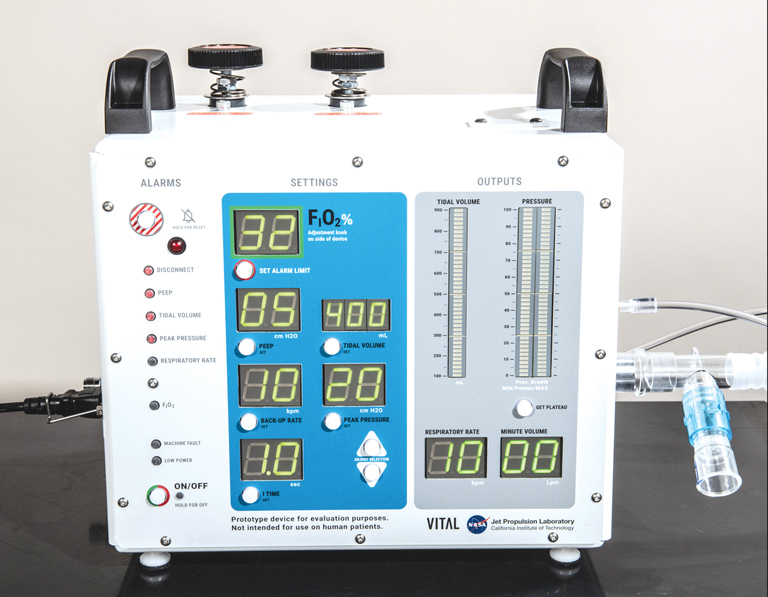
A front-facing portrait of VITAL (Ventilator Intervention Technology Accessible Locally), a ventilator designed and built by NASA’s Jet Propulsion Laboratory in Pasadena.
By Charly SHELTON
COVID-19 remains a major concern for medical professionals on the front lines of the pandemic and, while the number of new cases isn’t increasing as quickly as it once was, the number of cases is still on the rise in many places. Between the reopening of the country’s businesses, restaurants, gyms and event spaces and the mass gatherings at ongoing protests, medical leaders are debating whether the second wave will be worse than the first or whether the first wave has even ended yet.
Months ago, at the outset of the pandemic, ventilators became scarce. With thousands of patients at once in need of ventilators, the demand far exceeded the supply or even the ability to mobilize the industrial force of America to create enough medical supplies. Now, after weeks of preparation, scaling up and changing modes of production, companies around the world are ready to join the effort to make face masks, face shields and other basic health and safety supplies. But one desperately needed piece of equipment is more difficult to manufacture – ventilators.
The many small, complex parts and exacting specifications make them one of the harder supplies to scale up to manufacture unless a company is already set up for creating medical equipment. NASA’s Jet Propulsion Laboratory got to work on the problem and, after only 40 days, the scientists tasked with making a cheaper, quicker, easier-to-build yet equally effective ventilator, came up with a solution.
“It’s a new design. There were no blueprints for this. It was a new design based on input from medical professionals,” said Leon Alkalai, one of the leaders of the Ventilator Intervention Technology Accessible Locally (VITAL) team and manager of JPL’s Office of Strategic Partnerships. “Then we tested it in the field at Mount Sinai Hospital in New York and then at UCLA Ronald Reagan Hospital. Then we [sought] medical approval from [the] FDA, which we got for emergency use authorization, and then we licensed the technology. Now we’ve licensed it to 21 companies.”
The ventilator is approved by the FDA for Emergency Use, allowing doctors to assign the VITAL ventilator to patients with less severe symptoms thereby freeing up traditional ventilators for those in greater need.
“It’s designed specifically to address the COVID-19 respiratory needs of patients. So it’s specifically tailored for not every use of a ventilator for every possible condition that one finds in the hospital, but more specifically to the respiratory needs of patients suffering from COVID-19. And that was specifically gleaned from talking to the doctors who are treating such patients,” Alkalai said.
The blueprints for VITAL and the license to manufacture them were awarded to 21 companies from around the world which applied and were chosen based on their ability to scale the production up from whatever they produced previously and implement the proper practices for manufacturing the machine. The companies that applied all had medical device production experience, though not specifically ventilator making experience, or they could team up with other companies to meet the requirements together and be able to scale more effectively.
“So we’ve picked companies that I would say are not in the first, [that is] not the obvious, usual suspects in the ventilator business. Those typically have scaled up as much as they could; you know, the Medtronic and the Philips and the GE and a bunch of them have already done that,” Alkalai said. “They didn’t really apply for this license. It was mainly the small-to-medium-sized companies that have either teamed up or have already some experience with building medical devices … not all with ventilator experience, but experience with other medical devices and getting regulatory approval.”
This is a huge step in the ongoing battle against COVID-19 and for an innovative solution to a major problem, JPL seemed like the perfect place to start brainstorming.
“This FDA authorization is a key milestone in a process that exemplifies the best of what government can do in a time of crisis,” said NASA Administrator Jim Bridenstine in a released statement. “This ventilator is one of countless examples of how taxpayer investments in space exploration – the skills, expertise and knowledge collected over decades of pushing boundaries and achieving firsts for humanity – translate into advancements that improve life on Earth.”
